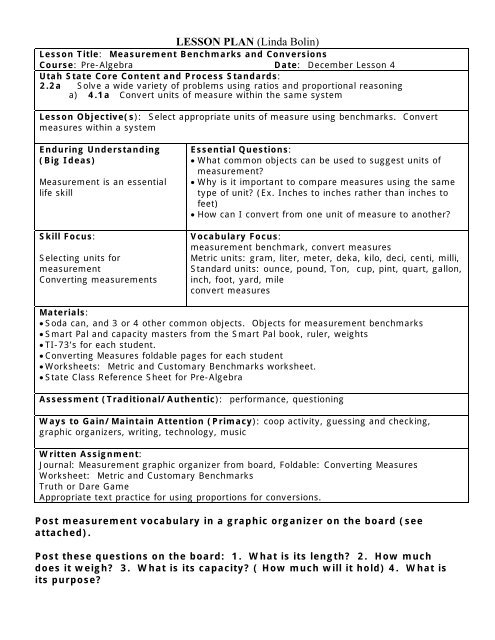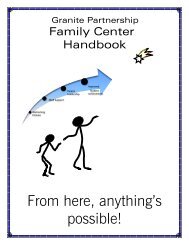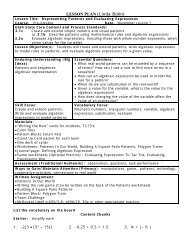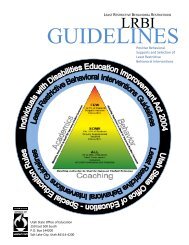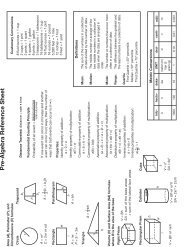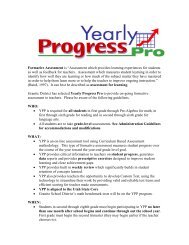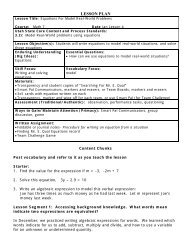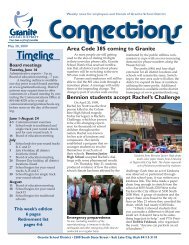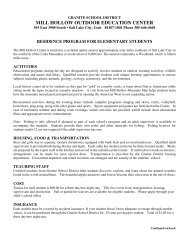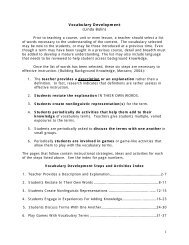LESSON PLAN (Linda Bolin) - Granite School District
LESSON PLAN (Linda Bolin) - Granite School District
LESSON PLAN (Linda Bolin) - Granite School District
You also want an ePaper? Increase the reach of your titles
YUMPU automatically turns print PDFs into web optimized ePapers that Google loves.
<strong>LESSON</strong> <strong>PLAN</strong> (<strong>Linda</strong> <strong>Bolin</strong>)<br />
Lesson Title: Measurement Benchmarks and Conversions<br />
Course: Pre-Algebra Date: December Lesson 4<br />
Utah State Core Content and Process Standards:<br />
2.2a Solve a wide variety of problems using ratios and proportional reasoning<br />
a) 4.1a Convert units of measure within the same system<br />
Lesson Objective(s): Select appropriate units of measure using benchmarks. Convert<br />
measures within a system<br />
Enduring Understanding<br />
(Big Ideas)<br />
Measurement is an essential<br />
life skill<br />
Skill Focus:<br />
Selecting units for<br />
measurement<br />
Converting measurements<br />
Essential Questions:<br />
• What common objects can be used to suggest units of<br />
measurement?<br />
• Why is it important to compare measures using the same<br />
type of unit? (Ex. Inches to inches rather than inches to<br />
feet)<br />
• How can I convert from one unit of measure to another?<br />
Vocabulary Focus:<br />
measurement benchmark, convert measures<br />
Metric units: gram, liter, meter, deka, kilo, deci, centi, milli,<br />
Standard units: ounce, pound, Ton, cup, pint, quart, gallon,<br />
inch, foot, yard, mile<br />
convert measures<br />
Materials:<br />
• Soda can, and 3 or 4 other common objects. Objects for measurement benchmarks<br />
• Smart Pal and capacity masters from the Smart Pal book, ruler, weights<br />
• TI-73’s for each student.<br />
• Converting Measures foldable pages for each student<br />
• Worksheets: Metric and Customary Benchmarks worksheet.<br />
• State Class Reference Sheet for Pre-Algebra<br />
Assessment (Traditional/Authentic): performance, questioning<br />
Ways to Gain/Maintain Attention (Primacy): coop activity, guessing and checking,<br />
graphic organizers, writing, technology, music<br />
Written Assignment:<br />
Journal: Measurement graphic organizer from board, Foldable: Converting Measures<br />
Worksheet: Metric and Customary Benchmarks<br />
Truth or Dare Game<br />
Appropriate text practice for using proportions for conversions.<br />
Post measurement vocabulary in a graphic organizer on the board (see<br />
attached).<br />
Post these questions on the board: 1. What is its length? 2. How much<br />
does it weigh? 3. What is its capacity? ( How much will it hold) 4. What is<br />
its purpose?
Starter:<br />
Content Chunks<br />
Start a journal page. Title it “Measurement”. Copy the vocabulary mind map<br />
neatly on the journal page.<br />
(see attached graphic organizer)<br />
Lesson Segment 1: What common objects can be used to suggest units of<br />
measurement?<br />
Ask students to mix around the room until you say “freeze”. The person closest<br />
to them becomes their partner. If no partner is immediately available they hold their<br />
hand up high and look for another hand up to be their partner. Have them introduce<br />
themselves to each other. Have them arrange themselves so that the partner with<br />
the most pets is facing the teacher and the other partner is standing back to back with<br />
their back facing the teacher. Tell them the facing-the-teacher partner will be<br />
describing an object and the back-to-teacher partner will be guessing what it is. Tell<br />
the facing-teacher partner to look at the questions you have posted on the board.<br />
They must use these for their clues to get the partner to guess the object. Hold up a<br />
soda can or other common object and have them give their clues. Then, have the<br />
partners change position, so the guesser now becomes the clue-giver. Have them<br />
look at the questions on the board to guide their clues. Hold up a second object.<br />
After this activity, ask the students which of the clues were difficult for them to<br />
give. Ask if any used metric measurements. Ask about how many cm the soda can<br />
is? Ask about how many gm it weighs when full and how many ml it will hold. These<br />
will be more difficult for the students to answer. Point out that this is because they do<br />
not regularly use metric units to measure. Read the “Metric Versus Customary”<br />
poem.<br />
Teach students the following song. As you sing each verse, choose one or two<br />
of the units for a stand and point activity. You will say a unit, for example<br />
“centimeter”, and have the students stand and point to something in the room that<br />
could be measured using a centimeter. Ask a couple of students to tell what they are<br />
pointing at. Ask them why the centimeter would be better than trying to use a<br />
millimeter or kilometer to measure the object they are pointing to. Repeat this Stand<br />
And Point activity for each verse choosing one or two units for students to think<br />
about.<br />
Knowing which system of measurement and which unit of measurement would<br />
be best to use is a vital skill. Selecting appropriate units can be more easily done if we<br />
can think of a common object to compare the measurements to. We call this common<br />
object a “measurement benchmark”.<br />
Work with students to complete the “Measurement: Metric and Customary<br />
Common Benchmarks” worksheet, showing some of the objects to the class to help<br />
them a visual. You may want to use the capacity pages in the Smart Pal masters<br />
book, a ruler, meter stick, some weights, etc for student reference.
Lesson Segment 2: Why is it important to compare measures using the same<br />
type of unit? (Ex. Inches to inches rather than inches to feet)<br />
Journal: Give each student a copy of the State Class Reference Sheet that can be<br />
used on the CRT tests. Students should keep this reference sheet in their journal for<br />
future use.<br />
Hand a student a regular size Hershey candy bar and you hold up a 1lb.<br />
Hershey bar. Tell the student can have it if theirs weighs more than yours. Have<br />
them read the weight on their package to the class and you look at yours and say,<br />
“Oh, no! Mine says it weighs only 1. Q. Why is this not an accurate comparison?<br />
Have two students come to the front of the class. Choose one that is about 6 ft.<br />
tall, and another much shorter. Use the ruler to measure the taller in feet and the<br />
shorter in inches and declare, “_______ (the shorter person) is the taller of the two.”<br />
When the class disagrees, defend by telling them how many inches. Q. Why is this<br />
not an accurate comparison?<br />
Obviously, when we are comparing, we need to use the same unit of measure.<br />
So, in order to compare, we must often convert units. We could use a Foldable to<br />
help us, a proportion, or we could use the graphing calculator. We will learn how to<br />
use each of these tools.<br />
Foldable: Fold the Converting Measures foldable so that the type of measure is a<br />
pocket inside a folder. Staple or tape the edges of the pocket. Cut out each<br />
measurement card. Help the students use the convert feature on the TI-73 and how<br />
to use a proportion to fill in the information on the cards. (In a proportion, one ratio<br />
is the number of smaller units in 1 of the larger units. The other is the information<br />
given and a variable). Have them practice a few with you.<br />
Staple or glue folded pocket to edge here.<br />
TI-73: Use the - < to convert measures. From the home screen type the<br />
number of units given. Push - < and select the type of measurement and the<br />
unit of measure given. Then select the unit of measure to convert to and press b.<br />
The home screen organizes the information so students can determine the scale factor<br />
used to convert the units. For example asking what 3<br />
was multiplied by to get 108 in this example, will<br />
help students find the scale factor.
Lesson Segment 3: Practice<br />
Game: Truth or Dare<br />
In this game questions are posted for the class to see or students are given a<br />
page of questions to answer. They may check with their team members for any they<br />
are not sure of. Once they have had a few minutes to check with team members, the<br />
teacher selects someone from the class to challenge another class member to, “Tell<br />
the truth, or take the dare!” The challenger asks one of the questions from the list.<br />
The student who was selected to tell the truth or take the dare must tell the truth<br />
about the problem or do a dare. The challenger dares the person to do something<br />
(that is not illegal, immoral, or extreme) such as sing Mary Had a Little Lamb, or do 5<br />
jumping jacks. The teacher, of course, has the final say as to whether a dare is<br />
appropriate or not. (Kids love this game). See the attached “Truth or Dare” page for<br />
examples. Students should be able to use their foldables or calculators since they are<br />
not required to memorize conversions.<br />
Assign additional text practice where proportions can be used for converting units as<br />
needed.<br />
Measurement Units Song<br />
(To Peter, Peter, Pumpkin Eater<br />
Lyrics by <strong>Linda</strong> <strong>Bolin</strong>)<br />
Inch and foot and yard and mile<br />
Distance measured with a smile<br />
Centimeter, meter too,<br />
Kilometer. How long are you?<br />
Ounce and pound and ton, Oh please<br />
Weigh it all with one of these<br />
Milligram and gram will do,<br />
Kilogram. How heavy are you?<br />
Ounce and cup, pint, quart and gallon<br />
Fill you up ‘til you are howlin’<br />
Millileter, liter too<br />
Fill ‘er up! How full are you?
Measurement<br />
Customary<br />
Metric<br />
Distance Weight Capacity Distance Weight Capacity<br />
inch<br />
ounce<br />
ounce<br />
meter 1 gram 1 liter 1<br />
foot<br />
pound<br />
cup<br />
milli 0.001<br />
yard<br />
ton<br />
pint<br />
centi 0.01<br />
mile<br />
quart<br />
deci 0.1<br />
gallon<br />
Unit 1<br />
deka 10<br />
hecto 100<br />
kilo 1000
Measurement: Metric and Customary<br />
Common Benchmarks<br />
Name ______________<br />
Date__________<br />
For each unit of measure in the table below, give another real world example.<br />
Type<br />
of<br />
measure<br />
Distance<br />
Length;<br />
Move<br />
across it<br />
Unit<br />
and<br />
symbol<br />
Centimeter<br />
cm<br />
(0.01 meters)<br />
METRIC<br />
Relation to Common<br />
Objects or Events<br />
1. A paper clip is about 1<br />
centimeter wide and 3<br />
centimeters long<br />
2. An unsharpened pencil is about<br />
20 centimeters long<br />
Another Real<br />
World examples:<br />
Meter<br />
m<br />
100 centimeters<br />
1. A full-size automobile is about<br />
two meters wide.<br />
2. Most classroom doors are about<br />
one meter wide.<br />
kilometer<br />
km<br />
(1,000 meters)<br />
1. 100 telephone poles end to end<br />
would extend about a<br />
kilometer.<br />
2. A kilometer is a little more than<br />
half a mile.<br />
Weight<br />
Pick it up<br />
Gram<br />
gm<br />
1. Two small paper clips weighs<br />
about a gram<br />
2. A nickel or a marble weighs<br />
about 5 grams<br />
Kilogram<br />
km<br />
(1,000 grams)<br />
1. The average weight of a<br />
newborn baby is 3 – 4<br />
kilograms<br />
2. A pair of men’s shoes weighs<br />
about one kilogram.<br />
Volume/<br />
Capacity<br />
Fill it up<br />
Temp<br />
Warm it up<br />
Liter<br />
L<br />
Degrees<br />
Celsius<br />
C<br />
1. Four average glasses hold<br />
about 1 liter of liquid.<br />
2. The gas tank of a full-size<br />
automobile holds about 90<br />
liters.<br />
1. Water freezes at 0 °<br />
2. A comfortable room is about<br />
21°
Type of<br />
Measure<br />
Distance<br />
Length;<br />
Move<br />
across it<br />
Unit and<br />
symbol<br />
Inch<br />
in or “<br />
Foot<br />
ft or ‘<br />
(12 in)<br />
Yard<br />
yd<br />
(3 ft)<br />
Customary<br />
Relation to Common Objects<br />
or Events<br />
1. A quarter is about an inch across<br />
the middle (diameter).<br />
2. A graphing calculator is about 7”.<br />
1. A ruler is one foot long<br />
2. A Math book is about a foot from<br />
top to bottom.<br />
1. From nose to tip of fingers on the<br />
outstretched arm of an average<br />
man is about a yd.<br />
2. The marked yard lines on a<br />
football field are 10 yards apart<br />
Another Real<br />
World Examples<br />
Mile<br />
mi<br />
(5,280 ft.)<br />
1. If walking briskly, an adult can<br />
walk a mile in 20 minutes.<br />
2. A mile is about a hundred football<br />
fields from goal post to goal post.<br />
Weight<br />
Pick it up<br />
Ounce<br />
oz<br />
Pound<br />
lb<br />
(16 oz)<br />
1. An average sized Snicker candy<br />
bar weighs about 5 ounces.<br />
2. A 50 cent piece weighs about half<br />
an oz.<br />
1. Two large apples weigh about a<br />
pound.<br />
2. An average newborn baby weighs<br />
between 7 and 8 pounds.<br />
Ton<br />
T<br />
1. 10 average men weigh about a<br />
Ton.<br />
2. A small car weighs about a Ton.<br />
Volume/<br />
Capacity<br />
Fill it up<br />
Ounce<br />
oz<br />
Quart<br />
qt.<br />
(32 oz)<br />
1. A soda can holds 12 oz.<br />
2. Your mouth can hold about 2<br />
ounces.<br />
1. A large drink at a convenience<br />
store holds about a quart.<br />
2. An average pitcher holds 2 quarts.<br />
Gallon<br />
gal<br />
(4 quarts)<br />
1. A gallon of chocolate milk serves<br />
about 12 people.<br />
2. An average home fish tank holds<br />
about 20 gallons of water.<br />
Temp<br />
Warm it up<br />
Degrees<br />
Fahrenheit<br />
F<br />
1. Water freezes at 32°.<br />
2. A comfortable room is about 72°.
Customary versus Metric<br />
“A pint is a pound the world around,”<br />
“It’s a cinch by the inch” don’t you know?<br />
If it’s “hard by the yard” then should we not discard<br />
An old system that’s awkward and slow?<br />
“A meter is neater” the world will declare,<br />
While the liter floods over the earth.<br />
The kilogram surely is choice of the masses,<br />
The decimal has infinite worth.<br />
A system of order; a system of sense;<br />
Who would want to use anything less?<br />
But I’m used to ounces and gallons and cups,<br />
So I guess I’ll put up with the mess.<br />
By Nancy Oliver
Truth Or Dare<br />
Measurement<br />
Name ___________<br />
Date ______<br />
1. A unit of measure for finding the length of a pencil<br />
could be a(n) ____.<br />
2. _____ is a word for a unit of measure that is common<br />
for both capacity and for weight.<br />
3. A unit of measure for capacity in the metric system is<br />
called a_________.<br />
4. Two systems of measures are _________ and ______.<br />
5. There are ________ milligrams in a gram.<br />
6. The metric system for measures is based on multiples<br />
of _____.<br />
7. A ____ is the customary unit for measuring a great<br />
distance, while a ___ is the metric unit.<br />
8. To convert liters to kiloliters, multiply liters by ____.<br />
9. To measure the weight of a marble, you should use<br />
a(n) _____.<br />
10. 3 yards is equivalent to _____ feet?<br />
11. 500 cm is equivalent to _____ meters?<br />
12. A gallon is equivalent to ____ quarts or ____ cups.<br />
13. 4.5 liters is _____ milliliters.<br />
14. 2 weeks is ____ hours.
Metric<br />
DISTANCE<br />
Metric<br />
WEIGHT (MASS)<br />
Unit<br />
Example<br />
Equivalency<br />
Unit<br />
Equivalency<br />
1 millimeter<br />
1 centimeter = _____ millimeters<br />
1 meter = _____ centimeters<br />
1 kilometer = ____ meters<br />
1 milligram<br />
1 gram = _____ milligrams<br />
1 kilogram = _____ grams<br />
1 Metric ton = _____ kilograms<br />
Unit<br />
1 milliliter<br />
Metric<br />
CAPACITY<br />
Equivalency<br />
1 liter = ______ milliliters<br />
1 kiloliter = ______ liters<br />
___ seconds = 1 min<br />
___ minutes = 1 hr<br />
___ hours<br />
___ days<br />
= 1 day<br />
= 1 wk<br />
TIME<br />
Metric<br />
TEMPERATURE<br />
___ months = 1 yr<br />
___ weeks = 1 yr<br />
_____ days = 1 yr<br />
0 ° = freezing<br />
21 ° = a very pleasant day temperature<br />
37 ° = normal body temperature<br />
100 ° = boiling
Customary<br />
DISTANCE<br />
Customary<br />
WEIGHT<br />
Unit<br />
Equivalency<br />
Unit<br />
Equivalency<br />
1 inch<br />
1 foot = ____ inches<br />
1 yard = ____ feet<br />
____ inches<br />
1 ounce<br />
1 pound = ____ ounces<br />
1 ton = ______ pounds<br />
__________ ounces<br />
1 mile = ______ yards<br />
_______ feet<br />
________ inches<br />
Unit<br />
1 ounce<br />
Customary<br />
CAPACITY<br />
Equivalency<br />
1 cup = ___ fluid ounces<br />
1 pint = ___ fluid ounces<br />
___ cups<br />
1 quart = ___ fluid ounces<br />
___ cups<br />
___ pints<br />
1 gallon = _____ fluid ounces<br />
____ cups<br />
___ pints<br />
___quarts<br />
___ seconds = 1 min<br />
___ minutes = 1 hr<br />
___ hours<br />
___ days<br />
= 1 day<br />
= 1 wk<br />
TIME<br />
Customary<br />
TEMPERATURE<br />
___ months = 1 yr<br />
___ weeks = 1 yr<br />
_____days = 1 yr<br />
32 ° = freezing<br />
72 ° = a very pleasant day temperature<br />
98.6 ° = normal body temperature<br />
212 ° = boiling


